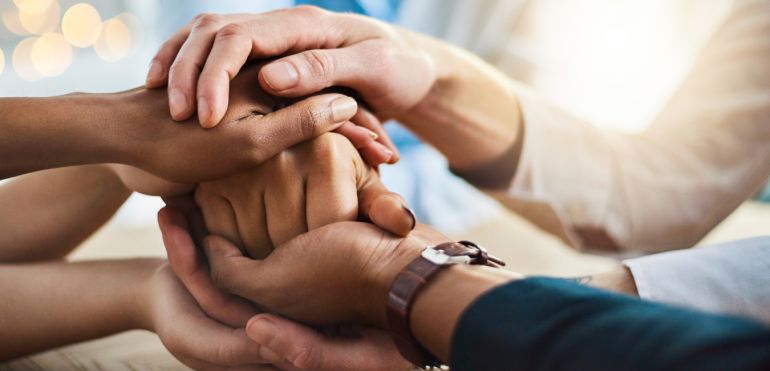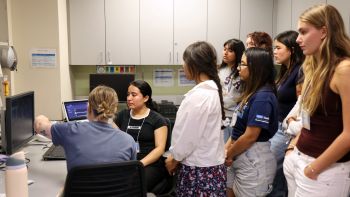Authors: Estelle Berger is a PhD student at the Developmental Social Neuroscience Lab at the University of Oregon (UO). Camille Cioffi, PhD, is a Research assistant professor at the Prevention Science Institute at UO. Leslie Leve, PhD, is the Lorry Lokey Chair in Education, Head of the Department of Counseling Psychology and Human Services in the College of Education, and Scientist at the Prevention Science Institute, all at UO. These insights are from their recent working paper, Supporting parents in recovery from opioid use disorder: Lessons learned from developmental science on parenting and adolescence.
Introduction
Rates of opioid use disorder (OUD) have continuously increased over the past decade, and more than half a million people with OUD are parents living with children. However, there is limited research on how to support parents in treatment for OUD, especially for those who are parenting adolescents.
To fill this gap, we were motivated to focus attention on how to support parents in treatment for OUD who are parenting adolescents, with the goal of alleviating parental concerns about the potential for intergenerational transmission of substance use disorders. We bring together what we know from research on adolescent development, parenting, and intergenerational transmission of substance use disorders to provide recommendations that support youth and their parents in treatment for OUD.
Parenting Adolescents in the Context of Opioid Use Disorder
Adolescents are hard-wired to establish a sense of autonomy, clarify personal identity, build peer and intimate relationships, and cultivate meaning and purpose. Adolescence can also be a time of heightened risk-taking, in which teens might engage in healthy risks like adopting a new hobby or joining an unfamiliar club, or venture toward more health-threatening risks. When a parent is in treatment for OUD, these defining elements of adolescence can be both strengths and vulnerabilities; youth might pivot toward or away from maladaptive behaviors, such as substance use, depending on the caregiving environment and other contextual factors.
The children of parents with OUD are at risk of developing OUD themselves. This “intergenerational transmission” becomes particularly apparent during adolescence when young people have more opportunities to try substances. They are also sensitive to social norms, and parents who use substances might normalize or provide opportunities for teens to use substances themselves. However, we wish to underscore that intergenerational transmission of OUD is not an inevitability.
When a parent is engaged in treatment for OUD, parent-child dynamics take on additional complexity. For example, with swings in mood that often accompany substance use, parents might engage in particularly harsh parenting, which can lead to aggression, substance use behaviors, and similarly harsh parenting style in future generations. While engaged in treatment, parents might struggle to provide consistent warmth and may be over-reactive. These parental behavior patterns may make youth more vulnerable to behavior problems, depression, and challenges in school. Some adolescents who have parents with substance use disorders also experience “parentification” (i.e., parenting their parent) as they provide physical and emotional care to their parent(s). While these attributes and parent-child dynamics are not solely a result of substance use, they point to a potential vulnerability within this parenting population.
Importantly, researchers have identified four factors that can protect adolescents from developing OUD:
- parental monitoring,
- parent-child relationship quality,
- parental support, and
- parental involvement.
In general, a consistent and nurturing parent-child relationship can help youth establish independence and a stronger sense of self. However, tensions with parents emerge during adolescence as youth seek more autonomy and peer connections yet still require monitoring, help with managing conflicts, and open communication with their parents. Conflict is a healthy part of a parent-adolescent relationship when there is safe space for a wide range of emotions and flexibility–like being able to laugh with each other after a difficult conversation or argument–can create generative opportunities for adolescents to express and regulate their emotions. A positive parent-adolescent relationship is a balance of autonomy, harmony, and conflict. Parents in treatment may need additional support in achieving this balance, but in doing so they might disrupt established cycles of detrimental conflict and foster new and more supportive relationships.
Recommendations
When thinking about how best to support adolescents and their parents, we need to pay attention to context. OUD does not occur in isolation. For example, parents who are in treatment for OUD often struggle with mental health issues, depend on other substances, have limited parenting support from partners, and experience a lack of resources in their communities (Cioffi et al., 2019; Peisch et al., 2018; Dawe et al., 2003). Additionally, OUD can occur in the context of persistent racism, policing, and cultural stigma. For the parent, the child, and the family as a whole, all of these factors impact and inform opportunities for intervention to provide a robust system of community support. At each level there are opportunities to create a dynamic system which engages the parent with OUD and their adolescent to intervene on problematic parenting behaviors that predict risk and nurture existing parenting strengths that offset that risk.
In Table 1, we provide recommendations to help guide adolescents, their parents, treatment providers, policymakers, and educators. In general, we provide resources to help adolescents build self-advocacy and communication skills, and identify ways that parents can shift behavior patterns when engaging with their children. We also emphasize how practitioners can facilitate a more family-centered approach to treatment, point schools toward establishing SUD/OUD prevention programs, and urge policymakers to fund those programs. By creating supportive systems that help heal the parent-adolescent relationship, we can work towards reducing the prevalence of intergenerational transmission of substance use including OUD.
Conclusion
Adolescents are important players in their own development; this age is a period of opportunity when young people are strengthening their sense of agency and beginning to make decisions that will affect their adult lives. Even in the midst of challenges, adolescents can experience positive development when systems and communities work together to support parents in recovery. By investing in parents, we are simultaneously investing in adolescents and nurturing the future opportunities that they seek to create.
Recommendations for supporting adolescents when a parent is engaged in treatment for OUD
From Berger, E. L., Barrett, A.-M., Mendes, S., Leve, L. D., Pfeifer, J. H., & Cioffi, C. (2022) Supporting parents in recovery from opioid use disorder: Lessons learned from developmental science on parenting and adolescence. Working paper.
![]()
Recommendations for supporting adolescents when a parent is engaged in treatment for OUD
Adolescents
- Practice compassion with yourself and your parent: The Seven Cs
- Identify ways to set healthy boundaries with your parent through support groups like Alateen and Narateen
- Understand more about addiction and substance use: Just Five, Tips for Teens, and It Feels So Bad
- Explore information about how opioids and other substances affect the brain: National Institute on Drug Abuse–Mind Matters
- Role play and practice how to avoid or leave a context where you may be peer pressured to use substances
- Seek Naloxone training. NARCAN is available at the pharmacy counter in all 50 states
- Find support for loss and bereavement in instances where you may not be able to have a relationship with your parent
Parents
- Regain adolescent’s trust – reduce/eliminate own substance use
- Build healthy communication patterns – provide emotional support, effective problem-solving, maintain parent-child boundaries, and monitor adolescent’s behavior while honoring the adolescent’s increasing autonomy
- Facilitate open conversations about substance use – highlight risks, share reflections on substance use, and communicate strategies that have helped to avoid substances
- Engage in active, shared activities like going to the movies, getting outside, or playing games
- Seek out peer support specialists and other providers
Treatment Providers & Other Mental Health Professionals
- Attend to parents’ needs both for substance treatment and support for parenting an adolescent
- Involve the family in treatment and facilitate opportunities to repair the parent-child relationship
- Collaborate with adolescents’ schools to provide additional support when parents are engaged in treatment – create an environment in which the adolescent can share openly without worry about child welfare involvement or stigmatization from peers
Schools
- Integrate primary prevention programs for OUD and SUD in curriculum
- Identify and serve students whose parents are engaged in treatment using a screening, brief intervention, and referral to treatment (SBIRT) model
- Create a strong sense of community within the school to provide an additional resource for students to turn to when parents are engaged in treatment
Policymakers
- Provide funding for primary, secondary, and tertiary prevention programs in schools and communities
- Generate and disseminate harm reduction information for adolescents and families
- Implement medication take-back programs to remove opioids and other unneeded prescription medications from homes



